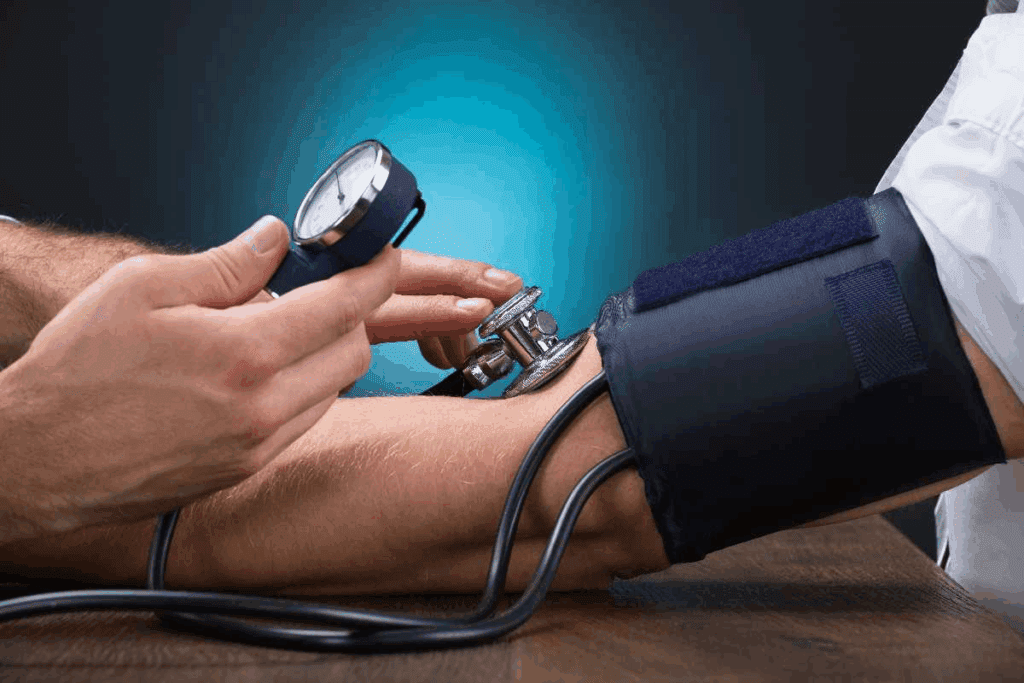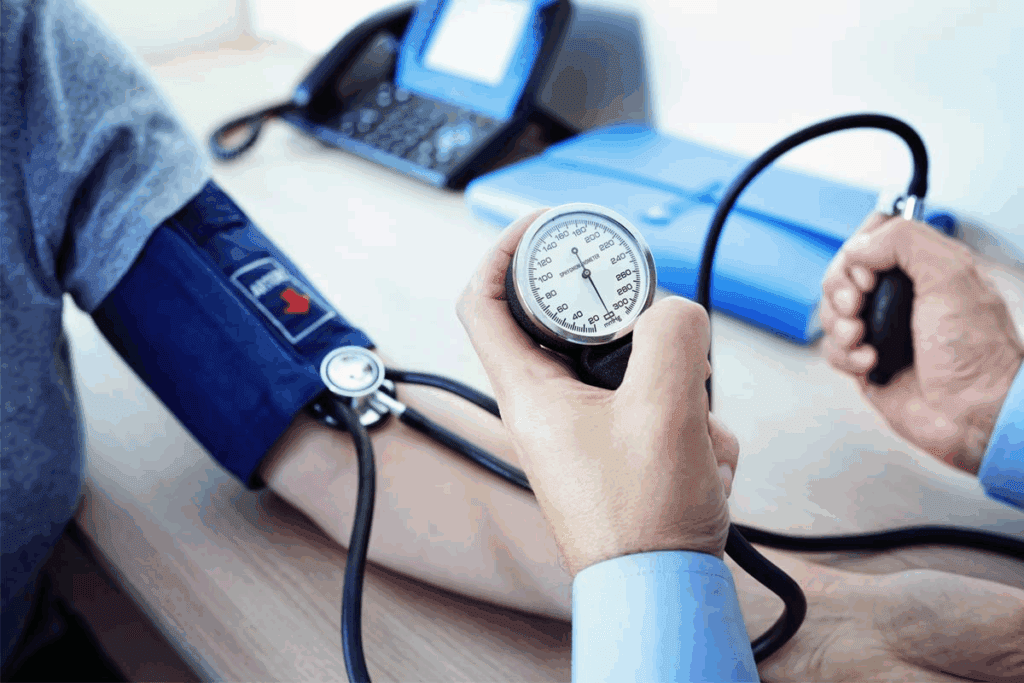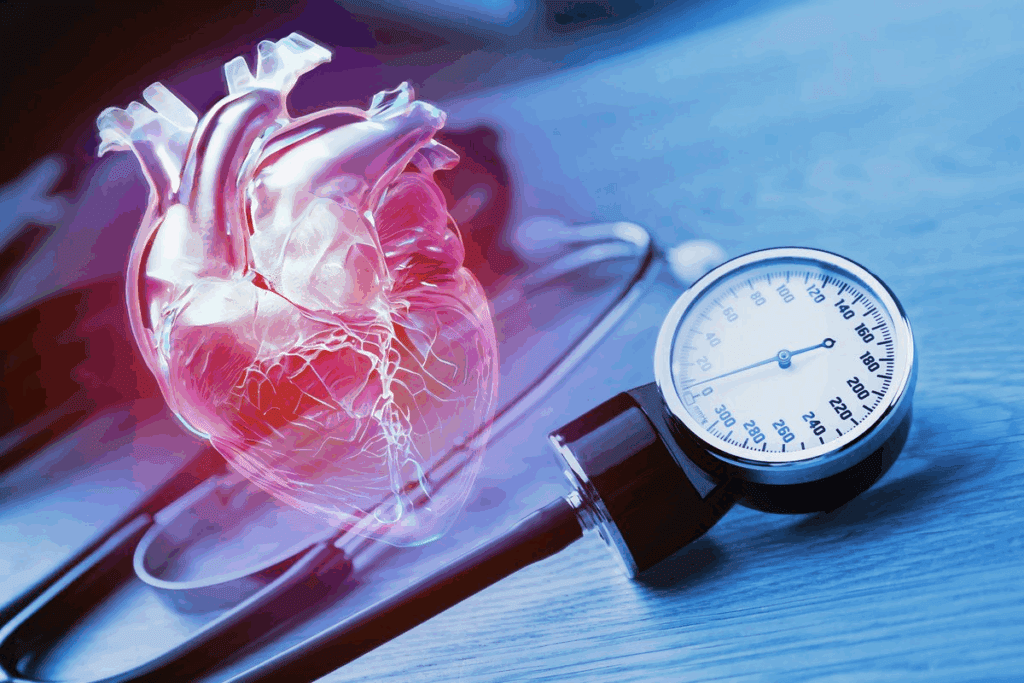
High diastolic blood pressure means your arteries have too much pressure between heartbeats. This is when the pressure is 80 mm Hg or higher. It’s called the “silent killer” because you might not feel any symptoms until it’s very bad.
Discover symptoms of high diastolic blood pressure and when to seek care.
Many people don’t notice any symptoms at first. But, you might feel headaches, dizziness, or get really tired. You could also have chest tightness or see things blurry. Spotting these signs early is key to avoiding big health problems.
At Liv Hospital, we focus on our patients to keep your heart safe. We help you catch and manage high diastolic bp symptoms before they get worse.

High diastolic blood pressure is a serious condition. It’s often called the ‘high bottom number.’ Blood pressure has two numbers: systolic pressure and diastolic pressure. Systolic is when your heart beats, and diastolic is when it rests.
The diastolic pressure, or the “bottom number,” is key. It shows the pressure in your arteries when your heart relaxes. A normal diastolic pressure is below 80 mmHg. Knowing this helps check your heart health.
Diastolic pressure is high at 80 mmHg or above. Isolated diastolic hypertension happens when the diastolic is high but systolic is normal. This can lead to serious heart problems if not treated.
Isolated diastolic hypertension (IDH) means high diastolic but normal systolic pressure. IDH can signal heart issues. We’ll look into IDH and why managing high diastolic pressure is important to avoid complications.

Knowing your diastolic blood pressure is key to keeping your heart healthy. It shows the pressure in your arteries when your heart is resting. A high reading can mean serious health problems if not treated.
High diastolic blood pressure is called a “silent killer” because it doesn’t show symptoms until it’s too late. It can harm your heart, kidneys, and blood vessels slowly. So, it’s important to check it often.
“Hypertension is a major risk factor for cardiovascular disease, and diastolic pressure is a key component of this condition,” says a leading health expert. Early detection and management are critical to preventing long-term damage.
Studies show that a 10 mm Hg increase in diastolic pressure raises heart risks. High diastolic pressure can lead to heart disease, stroke, and more. It’s important to control diastolic pressure to lower these risks.
High diastolic pressure can make blood vessels stiff and lose their flexibility. This makes it harder for them to handle blood pressure changes. It puts more strain on the heart.
Maintaining healthy blood pressure levels is vital for your blood vessels’ health. Exercise, a balanced diet, and managing stress can help keep your blood vessels healthy.
The signs of high diastolic blood pressure can be hard to spot. Yet, knowing them is vital for managing the condition well. Hypertension can quietly harm your body for years before a major event like a heart attack or stroke happens.
High diastolic blood pressure often doesn’t show obvious symptoms until it’s very severe. This is why it’s called a “silent killer.” Several reasons why symptoms are not noticed include:
So, many people don’t know they have high diastolic blood pressure until they have a big health issue or during a routine check-up.
When symptoms of high diastolic blood pressure show up, they can be different and affect many areas of health. Common symptoms include:
| Symptom | Description |
| Severe Headaches | Often described as throbbing or piercing, these headaches can be a sign of elevated blood pressure. |
| Dizziness and Lightheadedness | Feeling unsteady or faint can occur due to changes in blood pressure. |
| Nosebleeds | Frequent or severe nosebleeds can be a symptom of high blood pressure. |
| Heart Palpitations | Irregular heartbeats or palpitations can be a sign of cardiovascular strain. |
As Medical Expert, a cardiologist, notes,
“Recognizing the symptoms of high diastolic blood pressure is key for early action. Patients should know the possible signs and see a doctor if symptoms last or get worse.”
It’s important to watch for these symptoms and see a healthcare professional if they keep happening or get worse.
Headaches and dizziness often signal that your diastolic blood pressure is too high. These signs show your body is fighting to handle the pressure. It’s important to pay attention to them and see how they link to your blood pressure.
Morning occipital headaches are linked to high diastolic blood pressure. They happen at the back of your head and are usually worse in the morning. “The pain can be severe and is sometimes described as a pressing or throbbing sensation.” Doctors say these headaches can mean your blood pressure isn’t controlled well, mainly at night.
A study showed that people with high blood pressure often get morning headaches. This shows why it’s key to watch your blood pressure and manage it well to avoid these symptoms.
Dizziness and lightheadedness are also signs of high diastolic blood pressure. Vertigo, a feeling of spinning or being off-balance, can be very upsetting and affect your daily life. It’s important to see these symptoms as more than just minor issues. They could be signs of a bigger health problem.
A medical expert said,
“Dizziness and lightheadedness in patients with high diastolic blood pressure can be attributed to the body’s attempt to compensate for the increased pressure. This can lead to reduced blood flow to certain areas, causing these symptoms.”
In summary, headaches and dizziness are important warning signs. By understanding these symptoms and their link to high diastolic blood pressure, you can take steps to improve your health.
High diastolic blood pressure can affect the heart in many ways. It’s important to know these signs to keep your heart healthy.
Heart palpitations are a sign of high diastolic readings. They feel like your heart is racing or pounding. This can be a sign of heart problems.
While some palpitations are normal, frequent ones need medical help. This is true if they happen with high diastolic blood pressure.
Chest pain or discomfort can also be a symptom. It might feel like tightness or pressure. It’s a warning sign for heart issues.
Feeling short of breath, even when you’re not active, can be a sign. It means your heart might not be pumping well. This can cause fluid in your lungs, making it hard to breathe.
| Symptom | Description | Potential Implication |
| Heart Palpitations | Racing or pounding sensation in the chest | Irregular heartbeat, possible heart problems |
| Chest Pain | Pressure or tightness in the chest | Heart strain, possible heart issues |
| Shortness of Breath | Difficulty breathing during activity or at rest | Heart not pumping well, fluid in lungs |
Spotting these symptoms early can help manage high diastolic blood pressure. If you notice any, see a doctor right away. They can help prevent bigger problems.
It’s important to understand how high diastolic blood pressure affects our vision and brain. High diastolic blood pressure can cause symptoms that harm our heart, eyes, and brain.
Blurred vision is a common problem with high diastolic blood pressure. It happens when blood pressure damages the blood vessels in the eyes. This can lead to vision issues.
Some people also feel light sensitivity. They find it hard to be in bright places.
These vision problems can make everyday tasks hard. It’s key to keep an eye on blood pressure.
High diastolic blood pressure can also affect our brain. It can cause cognitive changes and brain fog. These changes might make it hard to focus, remember things, or think clearly.
Brain fog makes it hard to work and live our daily lives. It’s a confusing and unclear feeling.
Studies show that high blood pressure can change the brain. This can lead to these brain problems.
Nosebleeds can also be a sign of high diastolic blood pressure. While some nosebleeds are normal, too many or severe ones might mean high blood pressure. The high pressure can make blood vessels in the nose break, causing bleeding.
If you have frequent or severe nosebleeds, see a doctor. They can check for high blood pressure.
High diastolic pressure can cause many energy-related symptoms. It makes the heart work harder, leading to fatigue and other symptoms.
Many people with high diastolic blood pressure feel tired all the time. They might get enough sleep but feel very tired. This tiredness can make it hard to do everyday tasks.
Factors contributing to persistent tiredness:
High diastolic blood pressure can also make it harder to exercise. People might get tired quickly during activities they used to enjoy. This is because the heart can’t handle the extra work.
| Symptoms | Description |
| Shortness of breath | Feeling winded even at rest or during light activity |
| Fatigue during exercise | Feeling unusually tired or exhausted during physical activity |
| Muscle weakness | Feeling weak in the muscles, making it hard to perform daily tasks |
Morning exhaustion is another symptom of high diastolic blood pressure. Waking up tired can really affect your day. It might be because of poor sleep or the body’s struggle with high blood pressure.
It’s essential to address these symptoms to improve overall well-being and reduce the risk of complications associated with high diastolic blood pressure.
High diastolic blood pressure can deeply affect mental health. It leads to various psychological effects that can be distressing. These include anxiety, sleep disturbances, and mood changes.
Anxiety is a common effect of high diastolic blood pressure. Elevated blood pressure can cause feelings of unease and worry. Sometimes, this anxiety can turn into panic sensations, which are very distressing.
It’s important to recognize the link between diastolic blood pressure and anxiety. This is key to managing both conditions effectively.
High diastolic blood pressure can disrupt sleep, leading to insomnia and other sleep issues. Stress from elevated blood pressure makes it hard to fall asleep or stay asleep. Sleep disturbances can worsen the psychological effects of high diastolic blood pressure, creating a vicious cycle.
Mood changes and irritability are also effects of high diastolic blood pressure. The stress of dealing with elevated blood pressure can make people more irritable and prone to mood swings. Understanding this connection can help in managing these effects.
It’s vital to address the psychological effects of high diastolic blood pressure comprehensively. By managing blood pressure and associated psychological symptoms, individuals can improve their overall well-being and quality of life.
High diastolic blood pressure often shows common symptoms. But, there are less common signs that should not be ignored. These symptoms can point to serious health issues related to high diastolic pressure.
Ear ringing, or tinnitus, is a less common symptom of high diastolic blood pressure. It’s a constant ringing or buzzing in the ears with no outside noise. Tinnitus can show the body’s response to high blood pressure, hinting at vascular or circulatory problems.
Tinnitus can be very disturbing and affect daily life. If you have persistent ear ringing, seeing a healthcare professional is key. They can find the cause and suggest how to manage it.
Facial flushing is another symptom linked to high diastolic blood pressure. It’s when your face suddenly turns red, feeling warm or hot. Facial flushing happens when blood vessels near the skin’s surface widen, possibly due to blood pressure changes.
While occasional facial flushing might not worry you, frequent episodes could mean a blood pressure issue. Watching these episodes and talking to a healthcare provider can uncover related health problems.
Unexplained sweating can be linked to high diastolic blood pressure among other health issues. It’s sweating without a clear reason, like being hot or active.
Unexplained sweating might show the body’s stress response to high blood pressure. If you sweat a lot or often without reason, talking to a healthcare professional is important. They can check for any health problems.
It’s vital to recognize these less common symptoms of high diastolic blood pressure early. If you notice any of these signs, getting medical advice is essential for your health and well-being.
Elevated diastolic blood pressure comes from lifestyle choices, medical conditions, and genetics. Knowing these factors helps prevent and manage high diastolic blood pressure.
Lifestyle greatly affects blood pressure. A diet full of sodium and lacking potassium, not enough exercise, too much alcohol, and smoking can raise diastolic numbers. Maintaining a healthy lifestyle is key to managing and preventing high diastolic blood pressure.
Being inactive can lead to weight gain and obesity, big risks for high blood pressure. But, regular exercise can lower blood pressure and boost heart health.
Some medical conditions can also raise diastolic blood pressure. These include kidney disease, sleep apnea, and adrenal gland disorders. Kidney disease, for example, can cause hypertension because it affects fluid balance and hormone secretion.
| Medical Condition | Effect on Diastolic Blood Pressure |
| Kidney Disease | Can cause hypertension due to fluid imbalance and hormonal changes |
| Sleep Apnea | Repeated interruptions in breathing during sleep can lead to increased blood pressure |
| Adrenal Gland Disorders | Can result in excessive production of hormones that raise blood pressure |
Genetics also play a part in high diastolic blood pressure. People with a family history of hypertension are more at risk. Age-related changes, like stiffer arteries, can also raise diastolic numbers in older adults.
Knowing how these factors work together helps people take steps to manage their blood pressure. This can lower the risk of complications from high diastolic blood pressure.
High diastolic blood pressure is a serious issue that needs quick action. At Liv Hospital, we use the latest medical tech to help. Regular checks and management can stop serious health problems.
Knowing the signs and risks of high diastolic blood pressure is key. This knowledge helps people start managing their condition.
Dealing with high diastolic blood pressure means working with doctors to create a plan. This plan might include lifestyle changes, medicine, or other treatments. Taking these steps can lower the risk of health issues and improve overall health.
Managing high diastolic blood pressure is a long-term effort. It takes commitment and dedication. We urge readers to see a doctor if they have symptoms or concerns about their blood pressure.
By teaming up with healthcare providers, people can manage their condition well. This helps keep their heart health in top shape.
High diastolic blood pressure means the arteries’ pressure between heartbeats is too high. It’s usually over 80 mm Hg.
High diastolic blood pressure means the arteries don’t relax enough between heartbeats. This can harm your heart and blood vessels.
Yes, it’s very bad. It raises your risk of heart disease, stroke, and kidney problems.
Signs include headaches, dizziness, and heart palpitations. You might also feel chest pain, shortness of breath, or blurred vision.
Symptoms are often mild or slow to appear. This makes it hard to notice until it’s serious.
IDH is when your diastolic pressure is high but your systolic is normal. It’s risky for your heart and blood vessels.
It makes blood vessels stiff and less flexible. This increases your risk of heart disease.
Yes, it can. Morning headaches and dizziness are common due to increased blood vessel pressure.
High diastolic pressure raises your risk of heart attack, stroke, and kidney disease. It’s a serious warning sign.
To manage it, eat well, exercise, reduce stress, and consider medication if needed.
A diet full of salt and fat, not moving enough, smoking, and too much alcohol can all raise it.
Yes, kidney disease, sleep apnea, and adrenal gland disorders can all increase diastolic pressure.
Genetics and age can influence your risk. Some people are more likely to have high diastolic blood pressure due to their genes or age.
National Center for Biotechnology Information. (2025). 13 Symptoms of High Diastolic Blood Pressure You. Retrieved from https://www.ncbi.nlm.nih.gov/pmc/articles/PMC8099308/
Subscribe to our e-newsletter to stay informed about the latest innovations in the world of health and exclusive offers!
WhatsApp us